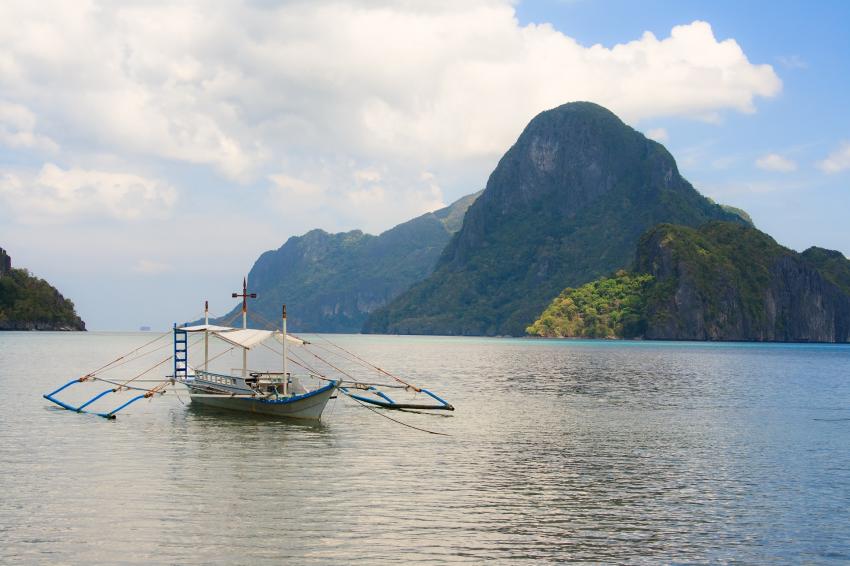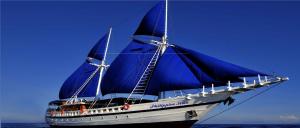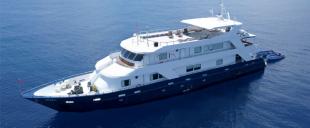LIVEABOARD DIVING IN Philippines

13
liveaboards
Price from
USD 1,350 per trip
The Philippines is recognized for its rich and diverse underwater environments, teeming with an array of marine life. Tubbataha National Park, part of the Sulu Sea, is known for its expansive dive sites. The Visayas region is another notable area where divers can explore sunken Japanese warships near Coron and extensive coral reefs around Cebu. Malapascua is where sightings of the elusive thresher shark are reported, while Bohol features vibrant coral reefs, and Leyte offers underwater caves.
In comparison to dive center-based diving, liveaboard diving in the Philippines allows for immediate access to more remote dive sites. The advantage here is efficiency, reducing travel time between locations and increasing the time available for diving. The experience is complemented by the amenities offered on Philippine liveaboard dive boats.
So, why is the Philippines such a popular spot among divers? One word: biodiversity. The Philippine's marine biodiversity is one of the richest in the world. From Jessie Beazley Reef to Apo Reef diving and Balicasag island diving, you'll come face to face with a myriad of sea creatures, from turtles and barracudas to various species of sharks and rays.
A dive safari in the Philippines often includes not only well-known sites but also hidden gems like Romblon, Camiguin diving, and southern Leyte diving. Dive into the waters of Mactan, Cebu City, and Moalboal to meet sardine balls, or head to Puerto Galera and Puerto Princesa diving spots to witness the stunning coral formations. For those interested in marine conservation, Apo Island diving offers fantastic opportunities to see community-led coral preservation efforts in action
Destinations in Philippines
Underwater adventure in the Philippines, a global hub for rich marine biodiversity. The Tubbataha National Park in the Sulu Sea captivates divers with its vibrant marine gardens and frequent sightings of pelagic species at the iconic Tubbataha dive sites. In the heart of the Visayas, Coron beckons with historic sunken warships and vibrant marine life, positioning it as a prime spot for wreck and Cebu city diving. Malapascua, another gem in the Visayas, promises unforgettable thresher shark sightings and Moalboal diving, known for its sardine runs and whale shark encounters in the Philippines. Bohol offers a remarkable underwater spectacle with pristine reefs and diverse marine ecosystems, particularly at sites like Balicasag Island. Meanwhile, Leyte provides a haven for macro photographers and muck diving enthusiasts, particularly known for southern Leyte diving. Apo Reef stands as a diver's sanctuary with vibrant corals and fish species, offering a thrilling Apo Island diving experience. Romblon invites divers to explore its clear waters and vibrant marine ecosystems, emerging as a pinnacle for scuba diving in the Philippines
When To Go Diving in Philippines
Dive season in Philippines is year-round but the dry season from November to June brings the warmest water and the best visibility. Diving in the Philippines is possible year-round but the dry season starts in November and lasts till June bringing with it the best conditions for diving. There are three distinct seasons in the Philippines. December-March is known for its northeast monsoon (called Amihan) with strong winds. April-June are the summer months with dry, warm days and a little wind. July-November is the time for southwest monsoon (called Habagat) with wet and rainy weather but the water still remains warm. The average air temperature ranges between 25-32°C/78-90°F. The average water temperature stays between 23-30°C/73-86°F depending on the season. Visibility ranges between 5-45m/16-148ft depending on the season and wind conditions. Depths range from 5m/16ft to 40m/130ft. Currents are mostly mild but always present due to the tidal flow between the islands. In some areas, currents can be very strong.
Tubbataha National Park in the Sulu Sea is best visited between March and June, when the park is open for diving and the seas are calm. Visayas, a central region of the Philippines, offers several notable diving locations like Coron, Cebu, Malapascua, Bohol, and Leyte. Here, the dry season is also the preferred time for diving, although some sites like Malapascua are known for thresher shark sightings year-round. Bohol, also part of the Visayas, offers excellent diving conditions from December to May, featuring famous spots like Balicasag Island. Leyte, another Visayas destination, is great for macro diving and is best visited between April and June. Romblon is another gem for macro photographers, and its diving season aligns with the dry months of November to May. Apo Reef, separate from Apo Island, is a magnificent atoll reef and is best visited during the dry season as well, especially from December to May, when visibility is at its peak
Departure ports in Philippines
Nestled in the heart of the Philippines, the bustling Port of Cebu beckons visitors with its promising adventures and scuba diving opportunities, particularly in the realms of Cebu City diving. Its strategic location near Mactan-Cebu International Airport (CEB) ensures a seamless journey, facilitating ease of access to the underwater splendors waiting nearby.
Puerto Princesa port serves as a tranquil gateway to underwater adventures. Easily reached through Puerto Princesa International Airport (PPS), this port promises enthralling Palawan diving experiences. Not far, the Port of Coron stands as a beacon for history and marine enthusiasts alike, renowned for its captivating wreck diving spots, offering a glimpse into the past amidst the vibrant underwater ecosystem. Accessible via Francisco B. Reyes Airport (USU), acts as a springboard to the stunning seascapes of Palawan, where a diverse range of marine creatures and picturesque reefs eagerly await visitors.
Further south, the Mactan port, situated close to the Mactan-Cebu International Airport (CEB), functions as a vital hub for travelers embarking on their underwater expeditions. This port region is not only a bustling embarkation point but also a renowned site for Mactan diving, offering an enticing glimpse into the marine life of the Philippines, with opportunities to encounter vibrant coral gardens and diverse marine species in their natural habitat
Must see dive sites in Philippines
The Philippines, a rich mosaic of dive sites, beckons underwater enthusiasts to explore its vibrant and diverse marine ecosystems. In the heart of the Sulu Sea, Tubbataha Reef offers a sublime diving safari, with pristine sites such as Jessie Beazley Reef. Here, divers can witness the remarkable Philippines' marine biodiversity, including schools of barracudas and manta rays amid healthy coral gardens. In the same region, the Delsan Wreck offers a sanctuary to a plethora of marine species, making it a magnet for those interested in liveaboard diving in the Philippines. Adjacent lies the Shark Airport, a paradise for shark enthusiasts, hosting an array of sharks from white tips to hammerheads. The Malayan Wreck and Amos Rock, also known as the "Washing Machine," offers thrilling drift dives with a whirlpool of marine life experiences.
Venture towards Malapascua, and you'll find Monad Shoal, a haven for thresher sharks, best visited during the Philippines diving season to catch a glimpse of these elusive creatures. Nearby, Gato Island is a cavern diver's paradise, boasting a variety of marine creatures including whitetip sharks and seahorses. The region also offers opportunities for Moalboal diving, known for its sardine runs and the vibrant Pescador Island.
In the Visayas, Oslob offers an unparalleled whale shark encounter in the Philippines, a must-visit site for every diver. Close by, the picturesque Sumilon offers fantastic coral gardens and vibrant marine life, providing an excellent site for both beginners and advanced divers. Bohol hosts spectacular sites like Balicasag and Cabilao, favorites for macro photography due to the rich marine life the Philippines has to offer.
For an exquisite Apo Reef diving experience, the Apo Island nestled within the Apo Reef, offers vibrant coral gardens teeming with turtles and colorful fishes, making it a top pick for diving holidays in the Philippines
Moalboal
Sumilon
Apo Island
Tubbataha Reef
Malayan Wreck
Jessie Beazley Reef
Amos Rock
Shark Airport
Frequently Asked Questions
Choosing the right itinerary for a Philippines liveaboard trip largely depends on a few key aspects including your diving proficiency, personal preferences, and the specific season. Here are several factors to consider:
Diving Experience: Different dive sites cater to various skill levels. For instance, if you're looking at embarking on a Philippines dive safari, destinations like Apo Reef and Anilao are perfect for beginners due to their relatively calm waters and vibrant marine life. On the other hand, seasoned divers may prefer the challenges posed by Tubbataha dive sites, known for their strong currents and deeper dives.
Marine Life Preferences: The Philippines is rich in marine biodiversity. Depending on your interests, you might opt for destinations renowned for specific marine encounters. For those looking forward to a whale shark encounter in the Philippines, Malapascua and Oslob are hotspots. Tailoring your itinerary to include dive sites known for specific marine encounters can greatly enhance your experience.
Seasonal Variations: The best time to dive in the Philippines can vary. For instance, the Tubbataha National Park is accessible only during a short season from March to June. Therefore, incorporating information about the Philippines diving season in your itinerary can be pivotal. Consider sites like Visayas, a year-round destination, to experience the best diving holidays in the Philippines.
Trip Duration: Depending on your available time, you may choose a shorter liveaboard trip focusing on a particular region like Apo Reef (noteworthy for Apo Island diving), or a more extended expedition that encompasses a broader area, potentially including stops for Puerto Princesa diving or Bohol diving, offering a more diversified array of dive sites
The Philippines is hailed as a diver's paradise for numerous reasons. Firstly, it is situated in the Coral Triangle, which is home to the richest marine biodiversity on the planet. You'll find a staggering variety of marine life in the Philippines, including a vibrant array of corals, myriad species of fish, and unique creatures such as thresher sharks, whale sharks, and pygmy seahorses.
Diving in the Philippines offers a blend of thrilling experiences and serene underwater vistas. The country boasts several world-renowned diving destinations, such as Tubbataha Reefs Natural Park, a UNESCO World Heritage Site, offering pristine coral reefs and awe-inspiring drop-offs. Other notable destinations include Malapascua, known for its thresher shark sightings, and Apo Reef, which is a magnet for underwater photographers due to its vibrant marine life.
Furthermore, the country presents a variety of dive sites that suit both beginners and advanced divers. Whether you are into muck diving, deep diving, or wreck diving, the Philippines has something for everyone. Moreover, the warmth of the Filipino people and the country's vibrant culture add a delightful touch to your diving experience.
Lastly, the Philippines offers diving year-round, with different regions having their peak seasons, allowing divers to choose itineraries based on their preferred diving conditions and marine life encounters. This versatility in diving conditions, coupled with the unparalleled biodiversity, makes the Philippines a top choice for divers globally
In the vibrant world of liveaboard diving in the Philippines, several liveaboards stand as the epitome of excellence and unforgettable underwater adventures. Among the favorites is the Philippine Siren, a name synonymous with luxury and comfort. This well-acclaimed option is a stalwart in the Philippines dive safari circuit, offering dive enthusiasts a chance to immerse themselves in the mesmerizing marine landscapes that the country is famous for. Equally prominent in the sector is Seadoors, a liveaboard that combines environmental sustainability with top-notch amenities. Its commitment to facilitating meaningful interactions with the vibrant Philippines' marine biodiversity is a highlight for many divers. Another remarkable name in the roster of popular Philippines liveaboard dive boats is Discovery Palawan. This vessel offers a myriad of itineraries, bringing divers to the front row of the stunning underwater spectacles scattered across the Philippine archipelago. Not to be missed, Infiniti embodies modern luxury, offering an array of personalized services that promise a memorable dive safari. Its ventures into the enthralling realms of Tubbataha Reefs or Apo Reef are experiences that resonate well with both novice and veteran divers. Lastly, Atlantis Azores holds a special place in the heart of the liveaboard diving Philippines community. Its luxurious offerings and well-crafted itineraries guarantee an underwater adventure that’s nothing short of magical. The professional crew and comprehensive amenities make it a preferred choice for many. Choosing the right liveaboard depends on your preferences, diving goals, and the specific regions in the Philippines you wish to explore. A thorough research and dialogue with these liveaboards can guide you to find the one that matches your diving dreams perfectly

